Have you ever wondered how to describe a position in Japanese? Picture this: you’re wandering through the busy streets of Tokyo and want to ask a local which way leads to the nearest train station. Or maybe you’re sitting in a Japanese classroom, and the teacher is giving directions like “Look up,” “Turn right,” or “Go down the stairs.” What exactly do these phrases mean?
Knowing how to say basic directions like “up,” “down,” “left,” and “right” in Japanese can make these moments much easier and more fun! In this guide, we’ll introduce you to the essential direction words in Japanese and show you how to use them naturally in everyday conversations. Let’s get moving!

Grammar Pattern to Describe Positions in Japanese
In Japanese, there are two main sentence patterns used to describe location, both simple and useful for beginners. In Japanese, to say where something is, you put the position word after the thing you are talking about. You connect them with the particle の (no). Then, you add the particle に (ni) or で (de) after the position word to show the location.
Let’s take a look at how to use them, along with examples to help you speak naturally and confidently!
1. ~ wa ~ no ~ ni arimasu/imasu
This structure emphasizes what you’re talking about first. For example:
テレビはテーブルの上にあります。
Terebi wa teeburu no ue ni arimasu.
The TV is on the table.
Here, “テレビ” is the topic, and the sentence explains its position.
2. ~ no ~ ni ~ ga arimasu/imasu
This structure is useful when pointing out or describing something in a place. For example:
テーブルの上にテレビがあります。
Teeburu no ue ni terebi ga arimasu.
On the table, there is a TV.
In both patterns, use います for people and animals, and あります for objects and inanimate things.
Note: Make sure to know how to read and write hiragana, as a lot of Japanese particles use them.
Positions in Japanese (With Examples)
Now that you know how to describe where something or someone is using basic sentence patterns, it’s time to learn the actual position words in Japanese! Thankfully, many of them correspond closely to English, like “up,” “down,” “left,” “right,” “inside,” and “outside.” These words are used together with particles like の (no) and verbs like あります / います to express location naturally.
One thing to note is the word まえ (前), which can be a bit tricky. It usually means “in front,” but in other grammar patterns, it can also mean “before” (as in time). Context is important, but with practice, you’ll quickly get the hang of it!
Here’s a helpful list of common position words in Japanese:
| apanese | Romaji | English Meaning |
|---|---|---|
| 上 | ue | up / above |
| 下 | shita | down / under |
| 前 | mae | in front / before |
| 後ろ | ushiro | behind |
| 中 | naka | inside |
| 外 | soto | outside |
| 左 | hidari | left |
| 右 | migi | right |
| 横 | yoko | beside / next to |
| 間 | aida | between |
Examples of Describing Up, Down, Left & Right in Japanese
1. 上: Above/on
かばんはいすの上にあります
kabanwa isuno ueni arimasu
The bag is on the chair
2. 下: Below/under

犬は木(き)の下にいます
ikuwa kino shitani arimasu
The dog is under the tree.
3. 左: Left

ペンの左に携帯(けいたい)があります
Penno hidarini keitaiga arimasu
There is a phone on the left side of the pen.
4. 右: Right

私(わたし)の右に先生(せんせい)がいます
Watashino migini senseiga imasu
There is a teacher on my right.
Examples of Describing Inside, Outside, Front, and Back in Japanese
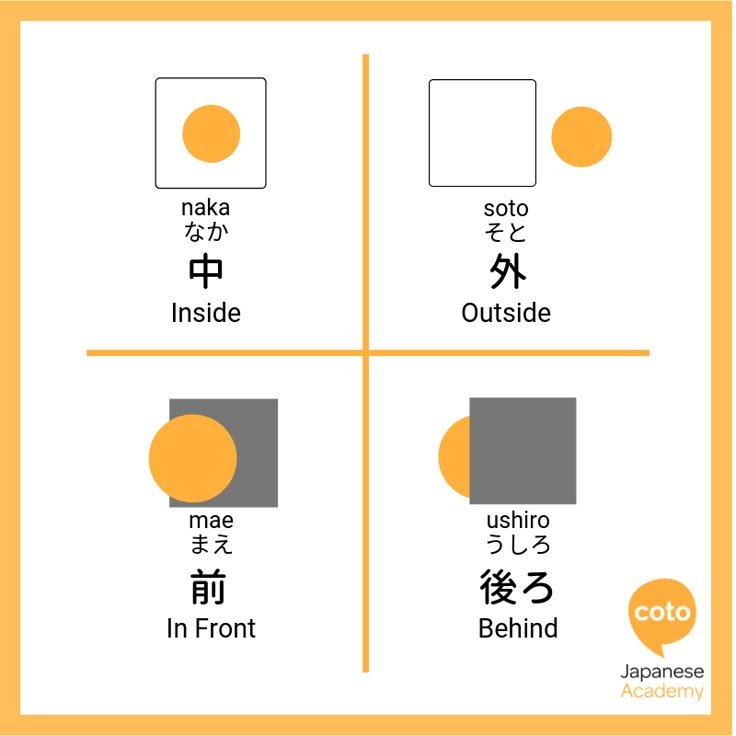
You can also use the two sentence patterns mentioned earlier to make sentences with these position words.
1. 中: Inside
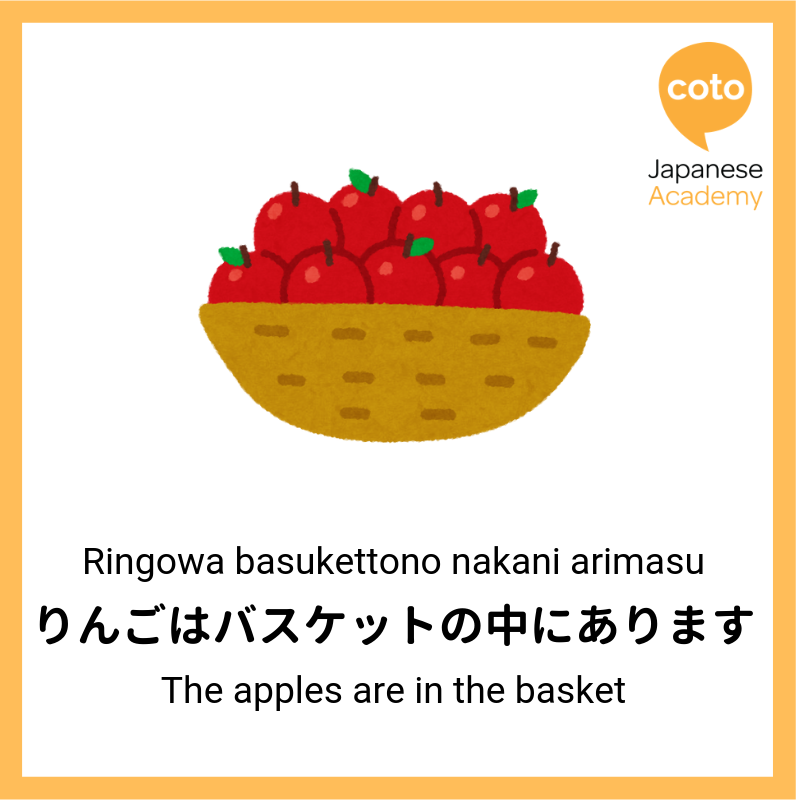
りんごはバスケットの中にあります。
Ringowa basukettono nakani arimasu
The apples are in the basket.
2. 外: Outside
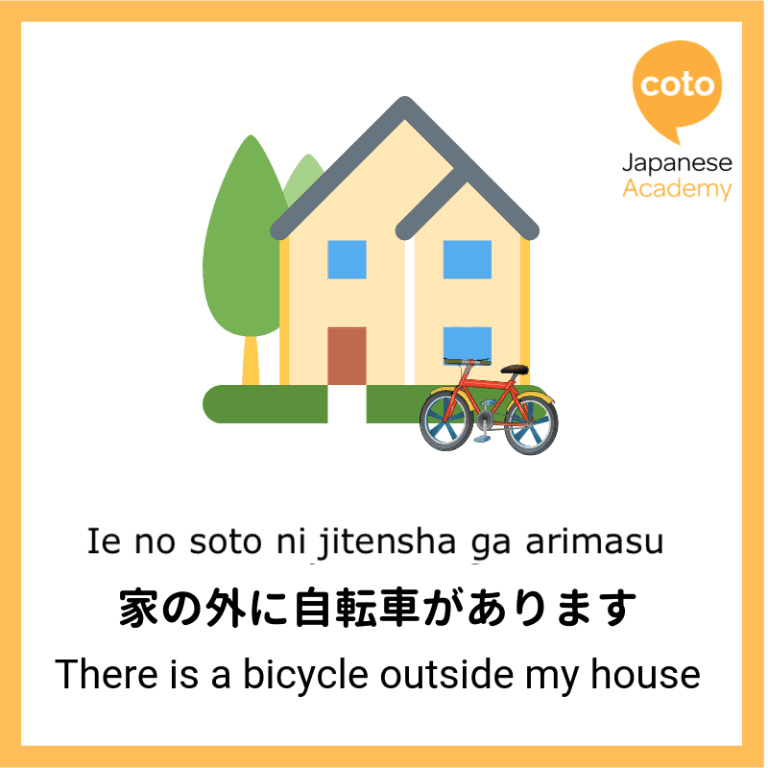
家(いえ)の外に自転車(じでんしゃ)があります。
Ieno sotoni jidenshaga arimasu
There is a bike outside my house.
3. 前: In front

テレビの前にボールがあります。
Terebino maeni bouruga arimasu
There is a ball in front of the TV.
4. 後ろ: Behind

子供(こども)の後ろ(うしろ)にねこがいます。
Kodomono ushironi nekoga imasu
There is a cat behind the kid.
5. 隣: Tonari
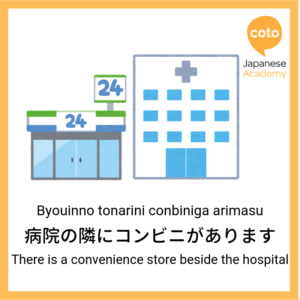
病院の隣にコンビニがあります。
Byouinno tonarini connbiniga arimasu
There is a convenience store beside the hospital.
6. 近く: Nearby something
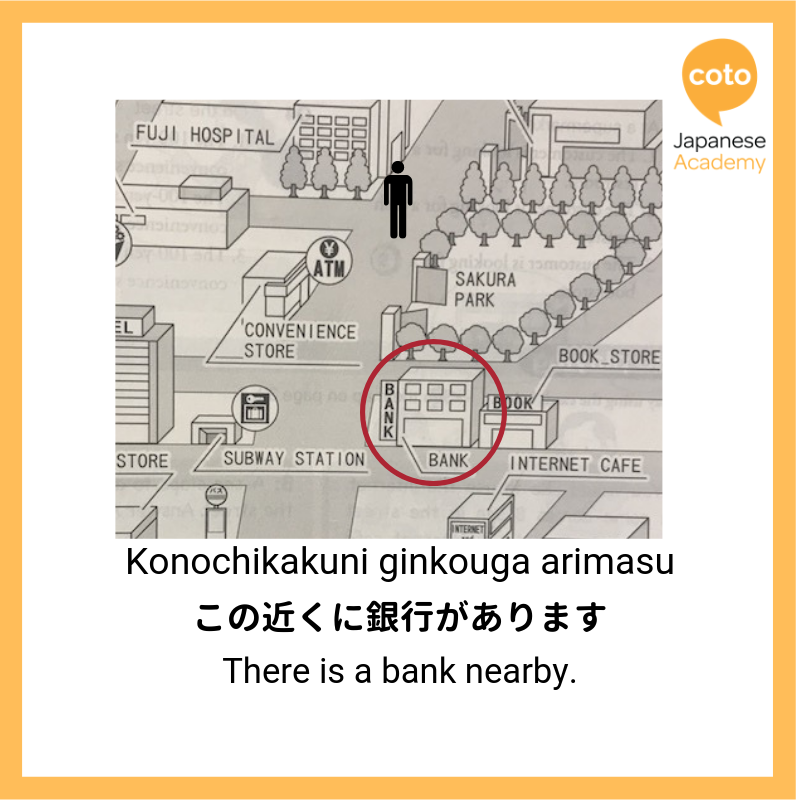
この近くに銀行があります。
Konochikakuni ginkouga arimasu
There is a bank nearby.
What’s Next? Learn More Phrases with Coto Academy!
Now you know the 10 common Japanese positioning words, do you know how to ask for directions in Japanese? What about other common Japanese phrases?
Master more basic Japanese language skills with Coto Academy, a leading Japanese language school with campuses in Iidabashi, Shibuya and Yokohama! Join part-time Japanese classes or a full-time intensive program based on your level and goal!
Want to learn more Japanese phrases? Read our guide on:
- How to Use Ganbaru, Ganbatte and Ganbare
- What Does Senpai (先輩) Mean in English?
- How to Use San, Sama, Kun
- How to Use Otsukaresama Desu in Japanese
- Basic Japanese Particles to Know
- Basic Japanese Sentence Pattern
FAQ
What are the post positions in Japanese?
Post positions in Japanese are particles like に (ni), で (de), and の (no) that come after words to show location, direction, or possession.
Do Japanese go up and down or left to right?
Japanese can be written both vertically (top to bottom, right to left) and horizontally (left to right).
How do you say up in Japanese?
Up in Japanese is 上 (うえ, ue).
How do you say left and right in Japanese?
Left is 左 (ひだり, hidari) and right is 右 (みぎ, migi).
The post Positions in Japanese: How to Say Up, Down, Left, Right and More appeared first on Coto Japanese Academy.
Article source: https://cotoacademy.com/positioning-words-japanese-how-to-say-left-right-japanese-position/

